Khamroev Elbert Elmurodovich
Bukhara Branch of the Republican Scientific Center for Emergency Medical Care, Uzbekistan
Correspondence to: Khamroev Elbert Elmurodovich, Bukhara Branch of the Republican Scientific Center for Emergency Medical Care, Uzbekistan.
Copyright © 2024 The Author(s). Published by Scientific & Academic Publishing.
This work is licensed under the Creative Commons Attribution International License (CC BY).
http://creativecommons.org/licenses/by/4.0/

Abstract
The prevalence of chronic heart failure and modern approaches to the treatment of heart failure as an important disease of the cardiovascular system, its prevalence, serious morbidity, high mortality and rapid growth of health care costs show how complex a problem this disease is. In this article, the analysis of the clinical situation of elderly patients with chronic heart failure and the role of age indicators in patients is devoted to its problem.
Keywords:
Heart failure, Old age, Decreased activity, Intracardiac pressure
Cite this paper: Khamroev Elbert Elmurodovich, Assessment of the Clinical Condition of Elderly Patients with Chronic Heart Failure, American Journal of Medicine and Medical Sciences, Vol. 14 No. 6, 2024, pp. 1529-1533. doi: 10.5923/j.ajmms.20241406.12.
1. Introduction
Chronic heart failure (CHF) manifests as a syndrome and consists of the following typical symptoms: shortness of breath, edema, fatigue, and reduced physical activity. At the same time, the typical clinical signs are also different, which include increased pressure in the jugular vein, wheezing in the lungs, and peripheral edema. These conditions are manifested when cardiac function and/or structure are impaired, in which intracardiac pressure increases both at rest and during physical exertion [1,3,5].SYuE is complicated in most cases when premorbidity is detected, but SYuE in the premorbid state has not been fully revealed in elderly and elderly patients, clinical and laboratory features have not been clearly shown, and the degree of influence of this background on SYuE has not been determined [2,4].
2. Material and Methods
A total of 219 patients were included in this study, of which 199 were elderly and elderly aged 60-80 years, and they were combined into the main group, and 20 patients under 60 years of age were included in the comparison group. The diagnosis of SYuE was verified in all patients. 99 (45.2±3.36%) of the participants were men and 120 (54.79±3.36%) were women. 106 of these patients were rural residents (48.40±3.38%) and 113 were urban residents (51.60±3.38%).When these patients were divided by age, the following results were obtained: 20 patients were under 60 years old (9.13±1.95%), 134 patients were 60-70 years old (61.19±3.29%), 61 patients were 71-80 years old (27, 85±3.03%), 4 were 81 years old and older (1.83±0.90) (Fig. 1).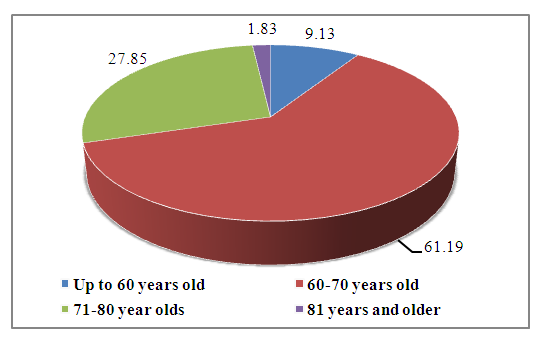 | Figure 1. Age distribution of patients with chronic heart failure (n= 219) |
In describing the patients, their gender, age, place of residence, as well as their profession or scope of activity are important, based on this, their social status was also studied. It was found that among the patients there were 194 pensioners (88.58±2.15%), 13 temporarily unemployed (5.94±1.60%), 4 teachers and medical workers (1.82±0.90%), workers, farmers and housewives made up 8 people (3.65±1.27%). There were 12 (5.48±1.54%) disabled people of the II group among the total studied (n= 219). Most of those studied were retirees, and no occupational or occupational diseases were identified.Researches were conducted in 2021-2023 at the Department of Emergency Cardiology of the Bukhara Branch of the Republican Emergency Medical Research Center. The final clinical diagnosis was based on the International Classification of Diseases (ICD-11). Their involvement in research was carried out on the basis of the Declaration of Helsinki adopted by the World Medical Association on the inclusion of human subjects in medical research (Helsinki, 1964, last updated in Fortaleza, 2013).Modern clinical methods were used during the research. The statistical processing of the obtained material was carried out using traditional variational statistical methods, in which "Excel" program was used. For this purpose, arithmetic mean size (M), arithmetic mean error of size (m), reliability of differences was determined according to Fisher-Student test (R). Statistical analysis "Pentium IV" was carried out using a software package for medical-biological research on a processor-based personal computer.
3. Obtained Results and Their Discussion
Today, studying complaints of patients in any pathology has not lost its clinical importance. Based on this, the level of complaints of patients diagnosed with SUE belonging to the general group was studied. A total of 24 different complaints were presented by patients, the intensity of which was different (Table 1).Table 1. Level of complaints of patients diagnosed with chronic heart failure, M±m
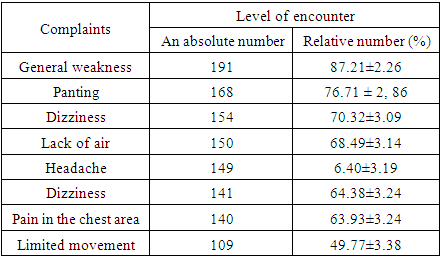 |
| |
|
When studying the complaints of all studied patients (n=219) in the course of this research work, in 100% of the cases, one of the complaints indicated by them was not emphasized by the patients. 7 of the total patient complaints were found in more than 50% of cases, of the remaining complaints, movement limitation was found in 49.77±3.38% (n=109) cases, and the main part was 0.91±0.64% (n=2) 19 Up to.63±2.68% (n=43) was determined. This was shown to be due to premorbidity and/or comorbidity in a wide spectrum of patient complaints, not all of which were related to SYuE alone.In addition to the patient complaints listed in Table 1, there are 16 more complaints, including cough (15.53±2.45%, n=34), cold sweats (15.53±2.45%, n=34), ear noise (19.18±2.66%, n=42), dry mouth (12.33±2.22%, n=27), shortness of breath (11.87±2.19%, n=26), pain behind the chest and heart palpitations (9.13±1.95%, n=20) were included, as the other indicated complaints were found in a small percentage (0.91 - 10.05%), we did not think it necessary to dwell on them in detail.The condition that characterizes these parameters is the degree of occurrence of these complaints in each patient. It was found that 219 studied patients had 6.72 complaints, of which 12.57% were related to premorbidity and/or comorbidity. This means that SYuE occurred in 1 out of every 8 patients observed. This case shows the importance of correct analysis of complaints in the diagnosis of SYuE, as well as identifying complaints related to premorbidity.Thus, when studying the frequency of complaints of patients observed by SYuE, there were 24 types of total complaints, 7 of them (general weakness, shortness of breath, dizziness, lack of air, headache, nausea, pain in the chest area) occurred in more than 50% of cases, each of the patients and one had 6.72 complaints. 12.57% of them were associated with premorbidity and/or comorbidity. The obtained results showed that it is important to study the complaints of patients, to connect them with premorbidity.In the interpretation and analysis of any pathology, the duration of the disease is also important, because this condition determines the tactics of treating the disease. It was found that the majority of patients diagnosed with SYuE have been experiencing a pathological condition for more than 15 years (65.75±3.21%, n=144), followed by those who have been ill for 10-15 years (29.22±3.07%, n=64), those who have been patients for 3-5 years (1.37±0.79%, n=3) and for 5-10 years (3.65±1.27%, n=8) were a minority (Fig. 2).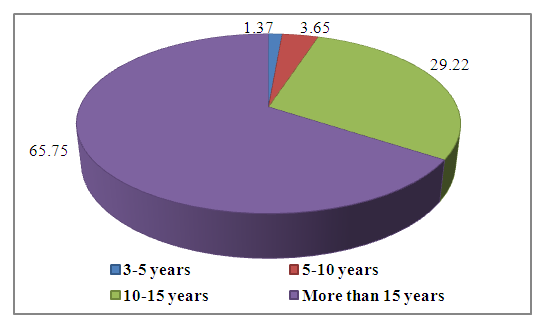 | Figure 2. Distribution of patients diagnosed with SYuE by disease duration, % |
It is noteworthy that all complaints related to premorbidity (12.75%) were observed in patients with a total duration of SYuE of more than 15 years, which indicates the influence of the premorbid condition on the duration of the disease. This determines the tactics of treatment of the disease.Thus, the majority of patients with SYuE (65.75%) were those whose disease continued for more than 15 years, 29.12% were patients for 10-15 years, a smaller percentage was 5-10 years (3.65%) and Those who were patients for 3-5 years (1.37%) were found. It is noteworthy that all the clinical signs defining premorbidity were present in those observed for more than 15 years. The reasons for this were, firstly, the age of the patients (60-75 years old), and secondly, the insufficient effect of the treatment of the disease, the addition of premorbid background to the main disease.The patients' complaints were studied along with their level of illness and their general condition was described. It was found that the general condition of 130 patients was moderate (59.36±3.32%) and 89 were severe (40.64±3.32%). For this reason, it was considered that they need constant treatment. During the study of the patients, it was found that the majority of them were conscious (91.32±1.90%, n=200), in 13 cases (5.94±1.60%) they were in a coma, 2 patients (0.91±0.64%) was comatose, 1 case (0.91±0.64%) was in stupor, 3 patients (1.37±0.79%) had signs of encephalopathy.When the lungs of the patients were auscultated, it was found that there were various changes in the lungs. In the main part of them, humid wheezing was heard in the lower part of the lungs - 68.49±3.14% (n=150), and during auscultation, slow vesicular breath was also detected from other clinical signs (47.03±3.37%, n= 103), cryptic breathing (2.74±1.10%, n=6) and dry wheezing (1.83±0.90%, n=4) were detected.It is noteworthy that, firstly, the incidence of auscultatory changes was related to the complaints of patients, and they were proportional to each other, and secondly, the incidence of lung changes corresponded to an average of 1.20 per patient, in numbers it looked like this - 263:219 =1.20. Auscultatory changes detected in the lungs were recognized as complications of SYuE.In these patients, together with the lungs, the heart was also auscultated, it was shown that the changes in the lungs depend on the pathological signs detected in the heart. In the heart, mainly muffled heart sounds were detected (89.04±2.11%, n=195), as well as a small number of peak systolic murmurs (13.70±2.32%, n=30) and arrhythmic heart sounds (2,28±1.01%, n=5) was determined. The number of heart tone disorders detected during auscultation corresponded to 1.05 per patient (230:219=1.05). There were no patients without changes in heart tones.Their blood pressure was also measured to determine the auscultatory changes in the lungs and heart, the obtained individual data showed that most of the patients had symptoms of hypertension - 84.93±2.42% (n=186), the rest of the patients had blood pressure below the norm (4.57±1, 41%, n=10) or was at the normal level (10.50±2.07%, n=23). The percentage of those with high blood pressure was significantly higher than normal and low blood pressure by 8.09 and 18.58 times, respectively (R<0.0 01). A total of 16 patients (7.31±1.76%) had blood pressure higher than 200/110, and the remaining patients had a blood pressure of 130-190. In addition, the pulse of these patients was studied, the results showed that the average pulse of the patients was 90.37±1.56, 191 patients (87.21±2.26%) had unchanged average fullness and tension, while 28 patients (12.79±2.26%) had an arrhythmic pulse.Thus, when patients diagnosed with SYuE underwent clinical examination, it was found that 59.36% of them had a moderate general condition, and 40.64% had a severe condition. As a result of lung auscultation, auscultatory signs such as humid wheezing (68.49%), slow vesicular breath (47.03%), crepitating breath (2.74%) and dry whistle-like wheezing (1.83%) were revealed in his lower part. patients without auscultative symptoms were not observed. As a result of this investigation, the following peculiarities were revealed: firstly, the auscultatory changes were correctly proportional to the corresponding complaints of the patients; second, the auscultatory changes in the lungs corresponded to an average of 1.20 per patient. In the heart, mainly muffled heart sounds (89.04%), peak systolic noise (13.70%), and arrhythmic heart sounds (2.28%) were detected. The obtained results were interpreted as pathological auscultatory signs, changes in heart tones in the studied contingent as signs confirming this disease.Also, clinical signs determined by palpation and percussion were observed in patients. It was found that mainly 6 main characters prevailed (Table 2). The most common symptom was dry and rough tongue - 67.12±3.17% (n=147). In the next place according to the degree of encounter, the enlarged liver was cited - 43.84±3.35% (n=96).Table 2. Results of palpation and percussion examination in patients with SYuE, M±m
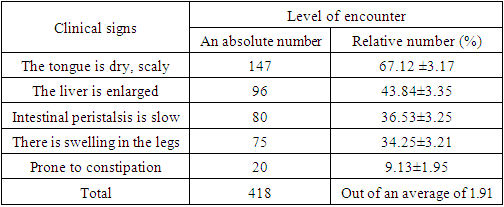 |
| |
|
Leg edema was detected in 75 patients (34.25±3.21%), clinical signs related to the gastrointestinal tract (slow intestinal peristalsis, tendency to constipation) were respectively 36.53±3.25% (n=80) and was found in 9.13±1.95% (n=20) cases. These signs corresponded to an average of 1.91 in patients.Thus, a total of 418 markers were identified in patients diagnosed with SYuE, which corresponded to an average of 1.91. It was found that 67.12% of the patients had a dry and crusty tongue, 43.84% had an enlarged liver, and 34.25% had swelling of the legs. Slowness of intestinal peristalsis and tendency to constipation were found in 36.53% and 3.13% of cases. The presence of premorbidity in patients with SYuE was interpreted as a factor aggravating their condition.Based on the study, comparison and analysis of all the above-mentioned clinical indicators, the main diagnosis was made to the patients (Table 3). It was found that most of the patients included in the research (79.0±2.75%, n=173) were diagnosed with the III stage of hypertension, but only 6 (2.74±1.10%) patients were diagnosed with the II stage of this disease.Table 3. The rate of occurrence of the main diagnoses given to patients diagnosed with SYuE, M±m
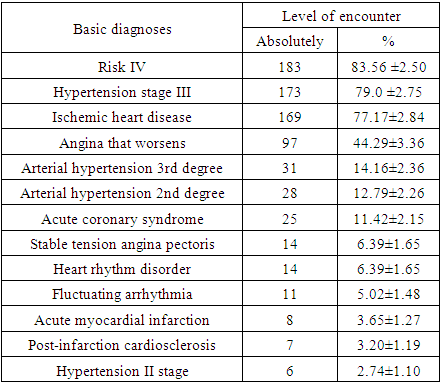 |
| |
|
Ischemic heart disease is one of the most frequent diagnoses - it was found in 169 patients (77.17±2.84%). One of the most common diagnoses is risk IV, which was given in 83.56±2.50% (n=183) cases.It is noteworthy that only the three main diagnoses listed above were given in large numbers (77.17±83.56%), the remaining diagnoses were given from 2.74% to 44.29%. The total number of primary diagnoses was 766, corresponding to 3.50 per patient (766: 219 = 3.50). This is typical for patients diagnosed with SYuE, and this pathology leads to complete damage to the cardiovascular system. This is important in determining the correct tactics of treatment of the disease.In addition to the main diagnoses, the degree of detection of the main diseases of the accompanying diseases in the patients was also studied (Table 4).Table 4. The rate of occurrence of concomitant diseases in patients diagnosed with SYuE, M±m
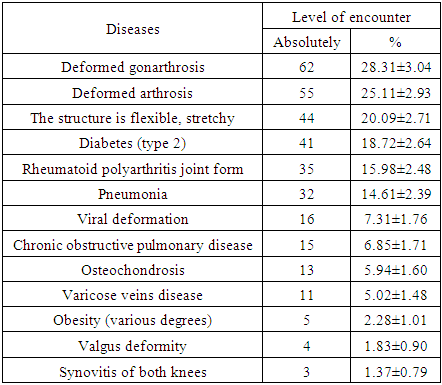 |
| |
|
It is known that concomitant diseases, when accompanied by the main diseases, cause a condition of camorroidism and/or preporbidity, thereby reducing the course of the main disease, the effectiveness of its treatment, and the patient's quality of life. That's why it's important to know their dating level.It was found that the patients with SYuE often had diseases of the locomotor system as co-morbidities. Among them, deformed gonarthrosis (28.31±3.04%, n=62), deformed arthrosis (25.11±2.93%, n=55), various contractures (20.09±2.71%, n= 44), belonging to the joint form we emphasize rheumatoid polyarthritis (18.72±2.64%, n= 35). Pneumonias (14.61±2.39%, n= 32) and diabetes (type 2) can also be cited as common comorbidities (18.72±2.64%, n= 41). Other accompanying diseases were found in patients from 1.37±0.79% (n= 3) to 7.31±1.76% (n= 16). Among the accompanying diseases, musculoskeletal system diseases are common, as well as pneumonia and diabetes mellitus were interpreted as noteworthy cases. It is noteworthy that comorbidities were recorded in a total of 336 cases, which corresponded to an average of 1.53 for each studied patient diagnosed with SYuE.In addition to primary and concomitant diseases, complications left by the primary disease were also studied in patients with SYuE. Determining these complications not only shows the course of the patient's main disease, the low effectiveness of treatment, but also is important for determining the outlook for the end of the disease.The incidence rate of main disease complications (Table 5) showed that cardiac asthma (38.36±3.29%, n= 84) was found as a complication in most patients.Table 5. The rate of occurrence of the main diagnoses in patients diagnosed with SYuE, M±m
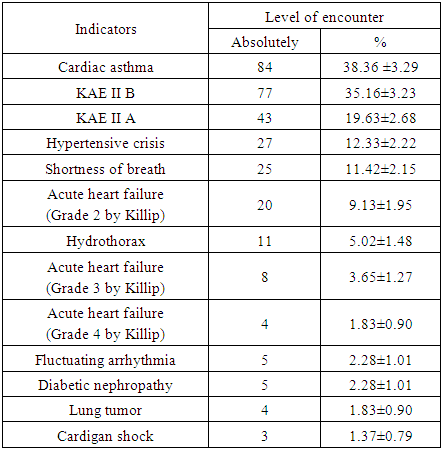 |
| |
|
It can be seen that KAE II B (35.16±3.23%, n= 77) and KAE II A (19.63±2.68%, n= 43) were sufficiently frequent, as well as acute heart failure. 2nd, 3rd, 4th classes according to Killip are also found in 32 patients (14.61±2.39%), which means that it occurs frequently as a complication. Complications such as hypertensive crisis (12.33±2.22%, n= 27) and shortness of breath (11.42±2.15%, n= 25) were interpreted as a noteworthy situation in practically one out of every 10 patients.An average of 1.43 (314:219=1.43) complications for each patient diagnosed with SYuE shows how serious this disease is, the addition of permorbidity not only aggravates the course of the disease or worsens the quality of life of patients, but also allows the increase of complications of the main disease.Thus, patients diagnosed with SYuE (n= 219) had a total of 706 primary diagnoses, corresponding to 3.50 per patient, the most common diagnoses being IV risk (83.56%), ischemic heart disease (77.17%), stage III hypertension (79.0±2.75%), worsening angina pectoris (44.29%), 3rd and 2nd degree arterial hypertension (14.16%) and acute coronary syndrome (11.42%) was introduced. Other major diagnoses ranged from 2.74% to 6.39%. Comorbidities were also identified, accounting for 1.53 per patient, with musculoskeletal disorders, pneumonia (14.61%) and type 2 diabetes (18.72%) being the most common. Other comorbidities occurred from 1.83% to 7.31%. The presence of accompanying diseases as a premorbid background to the main disease aggravates the course of this disease, worsens the patient's quality of life, and increases the number of complications. Cardiac asthma (38.36%), CAE II B (35.16%), CAE II A (19.63%), hypertensive crisis (12.33%) and respiratory failure (11.42%) were the main complications. can be cited, other complications occurred from 1.37% to 9.13%. Major disease complications were 1.43 per patient. The high level of their occurrence aggravates the course of SYuE, increases its duration, reduces the quality of life of patients, and makes it possible for the outlook of the end of the disease to be unpleasant.
4. Conclusions
1. Patients diagnosed with SYuE had 24 different complaints, 7 of them (general weakness, shortness of breath, dizziness, lack of air, headache, nausea, chest pain) occurred in more than 50% of cases, and each of the patients had 6.72 the complaint was correct. 12.57% of them were associated with premorbidity and/or comorbidity.2. The majority of patients with SYuE (65.75%) have had the disease for more than 15 years, 29.12% have been patients for 10-15 years, a smaller percentage has been 5-10 years (3.65%) and 3 Those who were patients for 5 years (1.37%) met. It is noteworthy that all the clinical signs defining premorbidity were present in those observed for more than 15 years. The reasons for this were, firstly, the age of the patients (60-75 years old), and secondly, the insufficient effect of the treatment of the disease, the addition of premorbid background to the main disease.3. The general condition of 59.36% of the patients diagnosed with this pathology was found to be moderate, and 40.64% had a severe condition. Auscultatory signs such as humid wheezing (68.49%), slow vesicular breath (47.03%), crepitating breath (2.74%) and dry whistling (1.83%) were found in the lower part of the lung. As a result of this investigation, the following peculiarities were revealed: firstly, the auscultatory changes were correctly proportional to the corresponding complaints of the patients; second, the auscultatory changes in the lungs corresponded to an average of 1.20 per patient. In the heart, mainly muffled heart sounds (89.04%), systolic noise at the peak (13.70%), and arrhythmic heart sounds (2.28%) were detected. Hypertensive symptoms were found in 84.93% of them, the percentage of those with high blood pressure was significantly higher by 8.09 and 18.58 times compared to those with normal and low blood pressure, respectively (R<0.0 01).4. A total of 418 clinical signs were identified in patients diagnosed with SYuE, which corresponded to an average of 1.91. It was found that 67.12% of the patients had a dry and crusty tongue, 43.84% had an enlarged liver, and 34.25% had leg swelling. Slowness of intestinal peristalsis and tendency to constipation were found in 36.53% and 3.13% of cases. The presence of premorbidity in these patients was interpreted as an aggravating factor.
References
| [1] | Nuraliev N., Jumaniyazov J. Immunological aspects of chronic kidney disease diagnosed in adult patients // BIO Web of Conferences. - EDP Sciences, 2024. - T. 100. - S. 02027. |
| [2] | Nuraliev N., Murotov N. Analysis of immune status assessment results of pregnant and breastfeeding women permanently residing in rural districts // BIO Web of Conferences. - EDP Sciences, 2024. - T. 100. - S. 02028. |
| [3] | Davuzov R. R. i dr. Sarcopenic syndrome: modern perspective and problem (Obzor literatury) // Vestnik Kyrgyzsko-Rossiyskogo Slavyanskogo universiteta. - 2018. - T. 18. – no. 2. - S. 104-108. |
| [4] | Chukaeva I. N. i dr. Priverjennost k lecheniyu pojilyx bolnyx s khronicheskoy sredechnoy dosstatochnostyu // Cardiology. - 2017. - T. 57. - no. 10. – S. 65-72. |
| [5] | Tsoi L. G., Sabirov I. S. Osobennosti techeniya chronicheskoi serdechnoi dostatochnosti u lits pojilogo vozrasta // Vestnik Kyrgyzsko-Rossiyskogo Slavyanskogo universiteta. - 2017. - T. 17. – no. 3. - S. 74-78. |




 Abstract
Abstract Reference
Reference Full-Text PDF
Full-Text PDF Full-text HTML
Full-text HTML



